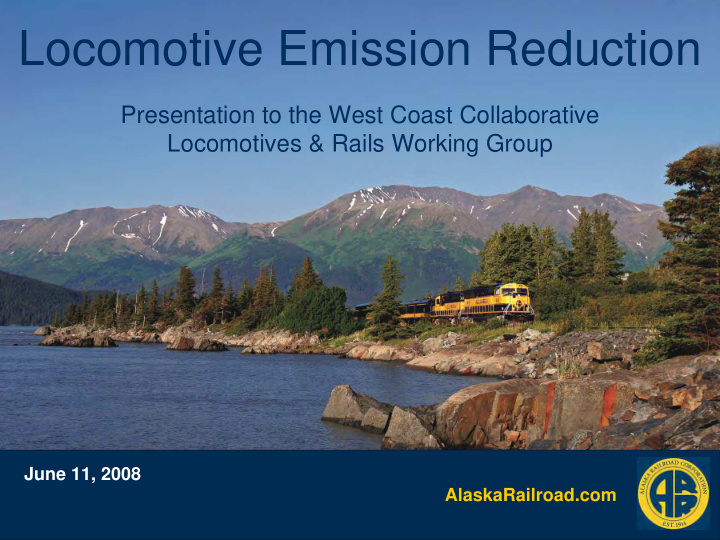



Locomotive Emission Reduction Presentation to the West Coast Collaborative Locomotives & Rails Working Group June 11, 2008 AlaskaRailroad.com
Presenters � Don Freestone, Manager � Bruce Pryke, Director of Safety, Locomotive Operations Rules & Operating Practices � Mark Mitchell, Assistant VP, � Stephenie Wheeler, Public Health-Safety-Environmental Involvement Officer and Green Star Coordinator AlaskaRailroad.com
Alaska Railroad Locomotive Fleet � 55 locomotives that haul railcar consists � 2 cab cars (engineer control; no pull power) � 4 RDCs (old self-propelled passenger cars) � 1 DMU (new self-propelled, delivery 2008) AlaskaRailroad.com
Locomotive Emission Reduction Efforts 1. Purchase new, more efficient locomotives 2. Install engine idle reduction systems 3. Train operating policies for efficiency 4. Improved locomotive maintenance 5. Ultra Low Sulfur Diesel Fuel 6. Fuel Additives (experimental stage) AlaskaRailroad.com
1. New, More Efficient Locomotives � Half the ARRC locomotives (28 of 55) are SD70MAC models purchased since 1997 to replace aging GP 40 as railroad’s “workhorse” GP40-2 Locomotive SD70MAC Locomotive AlaskaRailroad.com
� Greater fuel efficiency: A train that required two (2) GP40s to pull requires just one (1) SD70MAC � Less emissions according to research � 2004 Southern States Air Resource Managers study: SD70MAC vs. GP40 emits significantly less brake-specific emissions in HC, CO, NOx and PM � 2004 California EPA Roseville Rail Yard Study: Diesel PM emissions markedly less in SD70MAC vs. GP40, whether idling or moving AlaskaRailroad.com
Cost of Locomotive Replacement � 1997 – purchased sixteen (16) SD70MACs (4000 HP) at $1.9 million each, delivered 1999-2000 � 2003 – purchased eight (8) SD70MACs (4300 HP) at $2.4 million each, delivered 2003-2004 � 2006 – purchased four (4) SD70MACs (4300 HP) at $3 million each, delivered 2007 AlaskaRailroad.com
2. Engine Idle Reduction Systems � Three-quarters (78%) of ARRC’s locomotives (43 out of 55) equipped with idle reduction system Quantity Locomotive Uses Idle Reduction System 28 SD70MAC Pax/Freight train hauling EMD AESS 3 GP40-2 Work train, short-run freight EcoTrans 12 GP40-2 Work, Pax/Freight None 8 GP38-2 Eco Trans/Hot Start Yard switching; Work train 4 MP15 Smart Start Yard switching AlaskaRailroad.com
Systems used by ARRC � GMD Auto Engine Start Stop (AESS) – shuts locomotive engine down after a period of no use/idling; and starts up when engine controls engaged or temperature drops too far. � Smart Start – similar to AESS, but designed for lower HP locomotives, such as the MP15s. Maintenance on SD70MAC’s AESS � KIM Hot Start – similar effect to plugging in a car’s engine block. Small diesel engine runs hot water through locomotive’s engine so it doesn’t need to run to warm up. � EcoTrans K9 APU – monitors locomotive cab to determine if in use and if not, locomotive engine is shut down. APU keeps air built up in hydraulic systems to keep oil and water warm, battery charged, etc. AlaskaRailroad.com
Cost of Idle Reduction Systems (2002) � AESS – installed on first 16 SD70MACs at $11,000 each. Later SD70MAC purchases came equipped with AESS at no additional cost. � EcoTrans – installed on seven (7) GP38s and three (3) GP40s at $52,000 each. � Hot Start – installed on one GP38 at $29,400. � Smart Start – installed on four MP15s at $12,000 each. AlaskaRailroad.com
3. Train Operations Policies ARRC trains engineers on fuel conservation and best operating practices to boost locomotive efficiency. An entire section of the ARRC Brake & Train Handling Manual is dedicated to Fuel Conservation. AlaskaRailroad.com
Best Practices for Fuel Efficiency � Brake & Throttle Techniques – Engineers make use of gravity and track resistance. � Shutdown Policy – reduces idling for locomotives not equipped with automatic shutdown systems. � Isolation Policy – Locomotives not needed to pull in a consist, are “isolated” so they are not using power to pull. AlaskaRailroad.com
4. Peak Performance Maintenance � Preventive maintenance policy to keep trains and locomotives in peak condition, maximizing power & minimizing emissions � CMMS scheduled maintenance � Daily visual monitoring for HP, excessive exhaust, leaks, etc. to detect problems. � Monthly oil analysis AlaskaRailroad.com
5. Ultra Low Sulfur Diesel Fuel � EPA mandates use of Low Sulfur Diesel Fuel (500ppm) by June 2007, phasing to Ultra Low Diesel Fuel (15ppm) by 2012. � ARRC made switch to ULSD in 2007 � Challenges with ULSD Fuel � More expensive – 10-12 cents more per gallon � 7% less BTU combustible = use 3-4% more fuel � Less Lubricity = harder on fuel system parts AlaskaRailroad.com
6. Fuel Additive Experiment � Suppliers Flint Hills adds lubricity additive to ULSD to meet locomotive engine manufacturer standards; ARRC has no control � ARRC began testing on handful of locomotives, adding DurAlt fuel additive. Manufacturer claims increased lubricity and reduced emissions. � Testing will continue on larger number of locomotives starting summer 2008 to conclude merits of DurAlt additive. AlaskaRailroad.com
Air Quality Green Star Award � ARRC’s efforts to reduce emissions from locomotives was a big part of our application for a Green Star Air Quality Award. This is in addition to recertifying our Green Star Award. � Award approved, with formal presentation on April 21. � Award calls for continual improvement. AlaskaRailroad.com
Recommend
More recommend